System Analysis and Design Report for My Health Record System Project
VerifiedAdded on 2020/02/24
|11
|2291
|360
Report
AI Summary
This report provides a comprehensive analysis of the 'My Health Record System,' a project initiated by the Australian government, focusing on secure cloud-based storage of patient data. It details the functional requirements, including authentication, summarization, authorization levels, and edit/update capabilities, and non-functional requirements such as functionality, usability, reliability, performance, supportability, configurability, and scalability. The report evaluates the strengths and weaknesses of an all-cloud environment, highlighting benefits like usability, bandwidth, reliability, manageability, disaster recovery, cost savings, and data availability, while addressing security concerns, vulnerability to attacks, dependencies, and initial costs. Furthermore, the report compares and contrasts the predictive and adaptive SDLC approaches, recommending the adaptive approach (Agile methodology) for its flexibility and ability to incorporate changes throughout the development process, making it suitable for the project's medium size and quality requirements. The report concludes that cloud storage is beneficial but security must be prioritized, summarizing key aspects of the system design and SDLC approach.
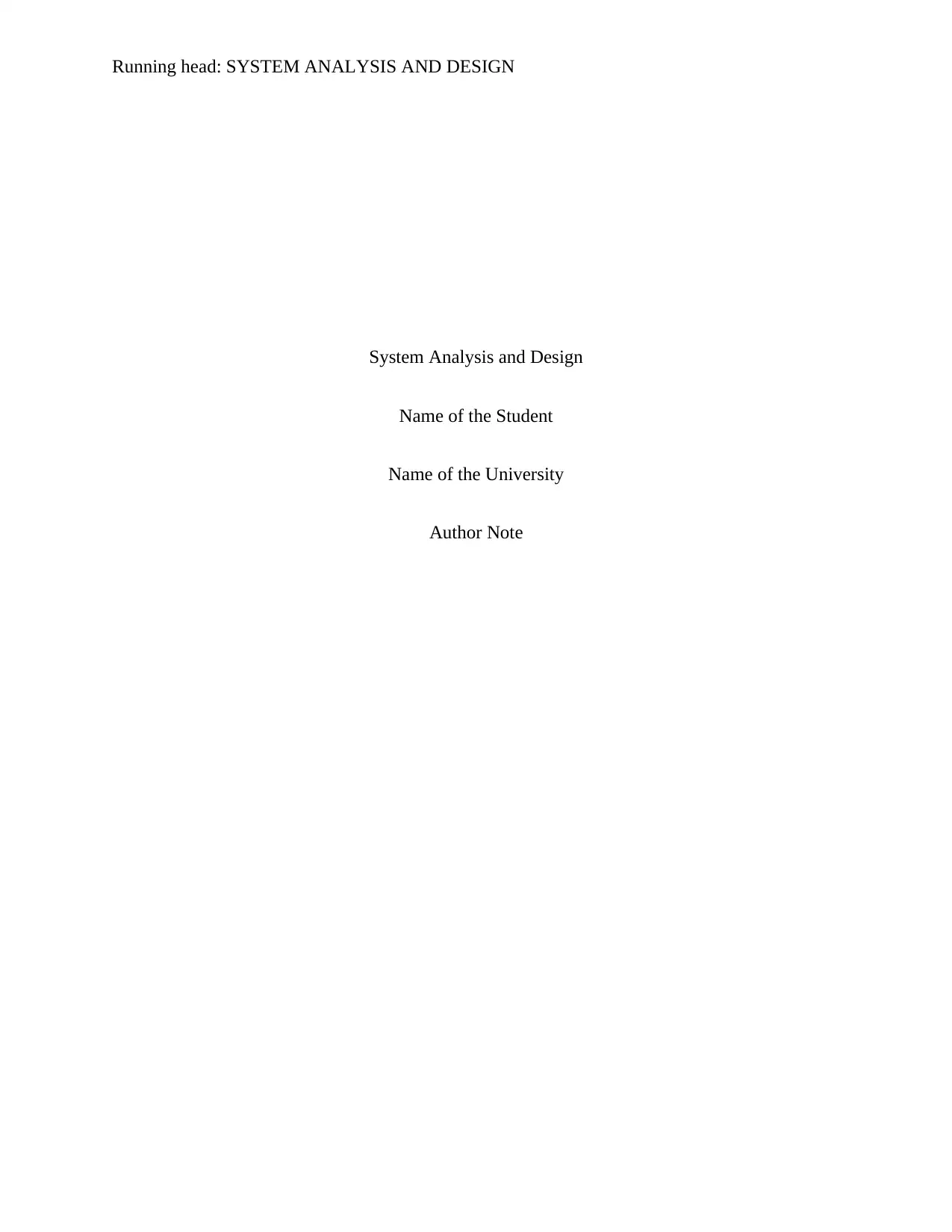
Running head: SYSTEM ANALYSIS AND DESIGN
System Analysis and Design
Name of the Student
Name of the University
Author Note
System Analysis and Design
Name of the Student
Name of the University
Author Note
Paraphrase This Document
Need a fresh take? Get an instant paraphrase of this document with our AI Paraphraser
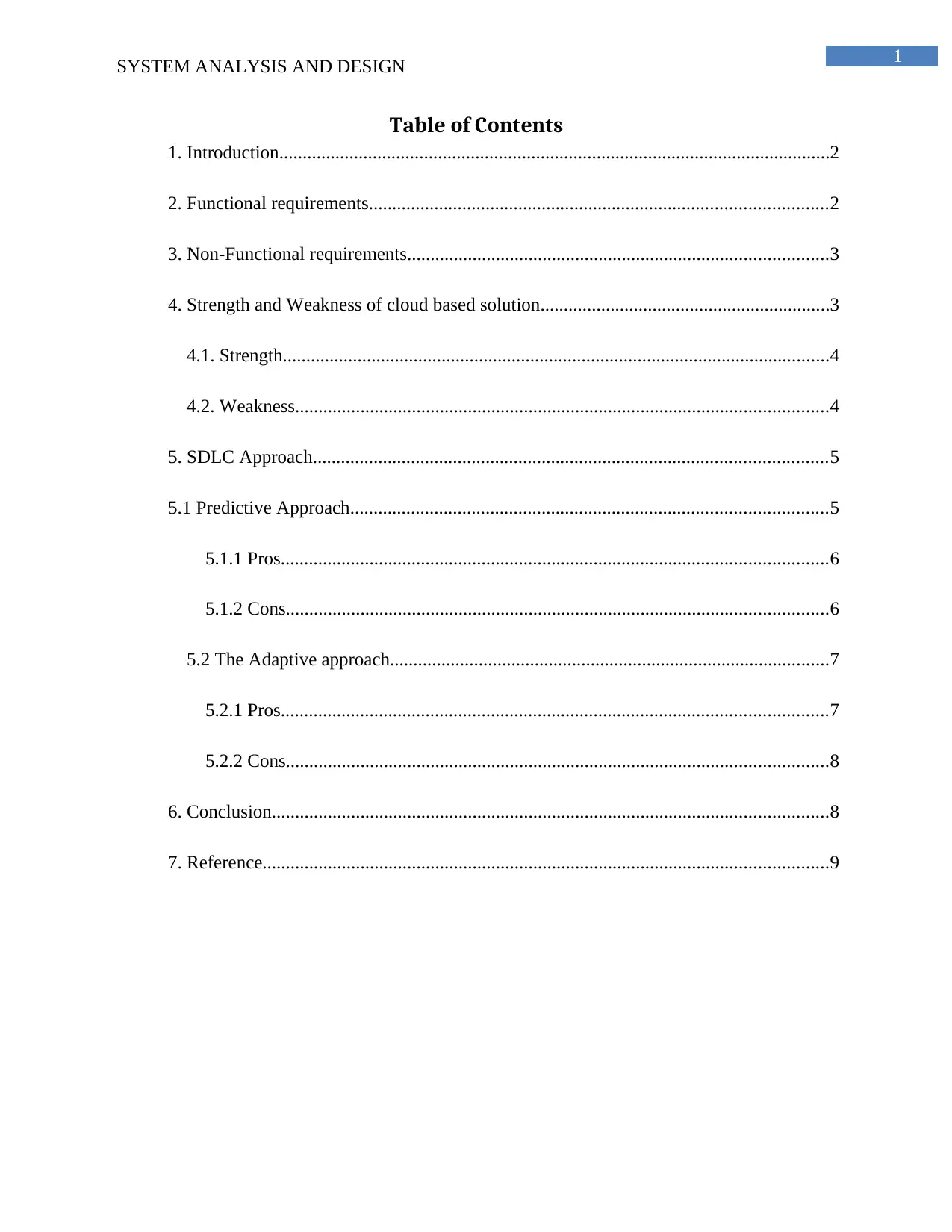
1
SYSTEM ANALYSIS AND DESIGN
Table of Contents
1. Introduction......................................................................................................................2
2. Functional requirements..................................................................................................2
3. Non-Functional requirements..........................................................................................3
4. Strength and Weakness of cloud based solution..............................................................3
4.1. Strength.....................................................................................................................4
4.2. Weakness..................................................................................................................4
5. SDLC Approach..............................................................................................................5
5.1 Predictive Approach......................................................................................................5
5.1.1 Pros.....................................................................................................................6
5.1.2 Cons....................................................................................................................6
5.2 The Adaptive approach..............................................................................................7
5.2.1 Pros.....................................................................................................................7
5.2.2 Cons....................................................................................................................8
6. Conclusion.......................................................................................................................8
7. Reference.........................................................................................................................9
SYSTEM ANALYSIS AND DESIGN
Table of Contents
1. Introduction......................................................................................................................2
2. Functional requirements..................................................................................................2
3. Non-Functional requirements..........................................................................................3
4. Strength and Weakness of cloud based solution..............................................................3
4.1. Strength.....................................................................................................................4
4.2. Weakness..................................................................................................................4
5. SDLC Approach..............................................................................................................5
5.1 Predictive Approach......................................................................................................5
5.1.1 Pros.....................................................................................................................6
5.1.2 Cons....................................................................................................................6
5.2 The Adaptive approach..............................................................................................7
5.2.1 Pros.....................................................................................................................7
5.2.2 Cons....................................................................................................................8
6. Conclusion.......................................................................................................................8
7. Reference.........................................................................................................................9
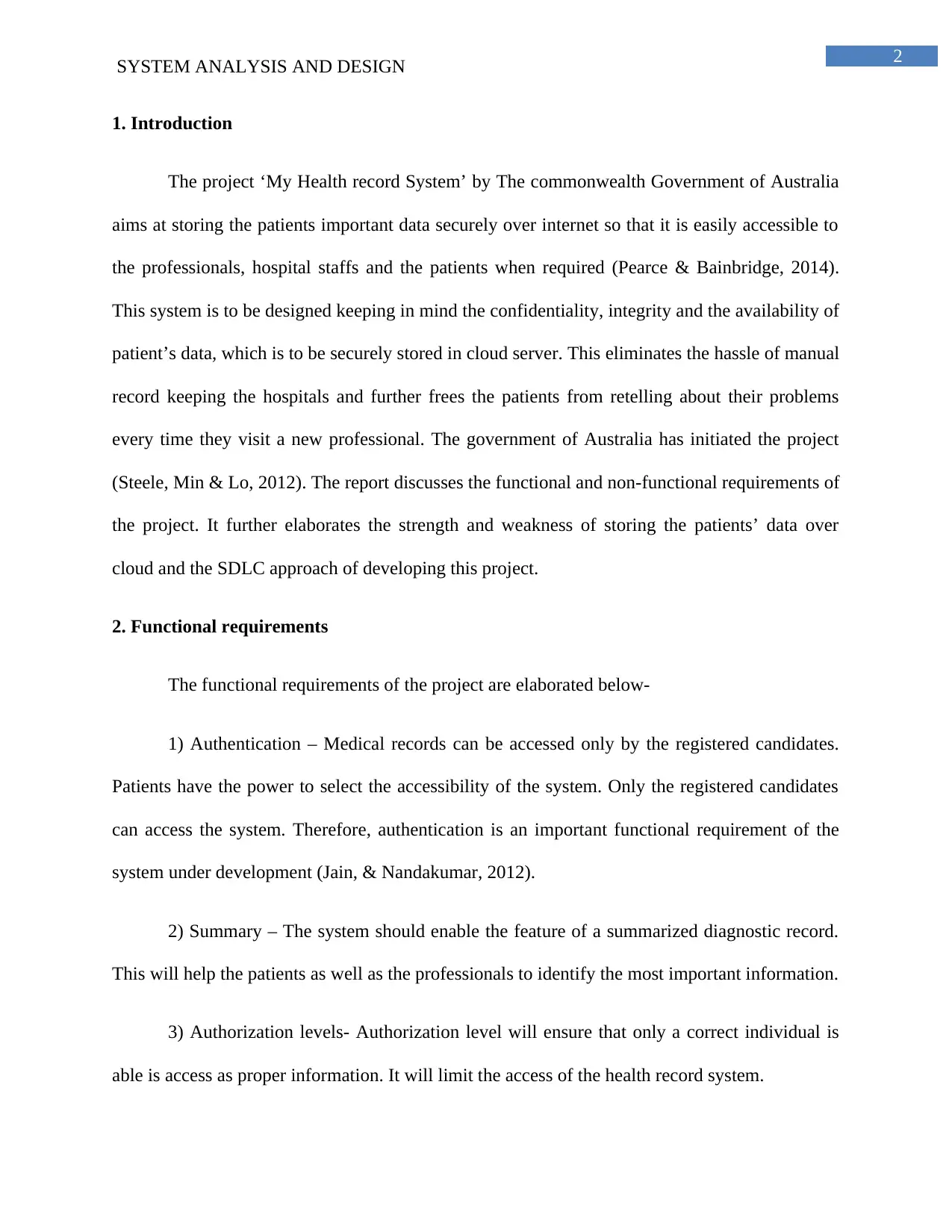
2
SYSTEM ANALYSIS AND DESIGN
1. Introduction
The project ‘My Health record System’ by The commonwealth Government of Australia
aims at storing the patients important data securely over internet so that it is easily accessible to
the professionals, hospital staffs and the patients when required (Pearce & Bainbridge, 2014).
This system is to be designed keeping in mind the confidentiality, integrity and the availability of
patient’s data, which is to be securely stored in cloud server. This eliminates the hassle of manual
record keeping the hospitals and further frees the patients from retelling about their problems
every time they visit a new professional. The government of Australia has initiated the project
(Steele, Min & Lo, 2012). The report discusses the functional and non-functional requirements of
the project. It further elaborates the strength and weakness of storing the patients’ data over
cloud and the SDLC approach of developing this project.
2. Functional requirements
The functional requirements of the project are elaborated below-
1) Authentication – Medical records can be accessed only by the registered candidates.
Patients have the power to select the accessibility of the system. Only the registered candidates
can access the system. Therefore, authentication is an important functional requirement of the
system under development (Jain, & Nandakumar, 2012).
2) Summary – The system should enable the feature of a summarized diagnostic record.
This will help the patients as well as the professionals to identify the most important information.
3) Authorization levels- Authorization level will ensure that only a correct individual is
able is access as proper information. It will limit the access of the health record system.
SYSTEM ANALYSIS AND DESIGN
1. Introduction
The project ‘My Health record System’ by The commonwealth Government of Australia
aims at storing the patients important data securely over internet so that it is easily accessible to
the professionals, hospital staffs and the patients when required (Pearce & Bainbridge, 2014).
This system is to be designed keeping in mind the confidentiality, integrity and the availability of
patient’s data, which is to be securely stored in cloud server. This eliminates the hassle of manual
record keeping the hospitals and further frees the patients from retelling about their problems
every time they visit a new professional. The government of Australia has initiated the project
(Steele, Min & Lo, 2012). The report discusses the functional and non-functional requirements of
the project. It further elaborates the strength and weakness of storing the patients’ data over
cloud and the SDLC approach of developing this project.
2. Functional requirements
The functional requirements of the project are elaborated below-
1) Authentication – Medical records can be accessed only by the registered candidates.
Patients have the power to select the accessibility of the system. Only the registered candidates
can access the system. Therefore, authentication is an important functional requirement of the
system under development (Jain, & Nandakumar, 2012).
2) Summary – The system should enable the feature of a summarized diagnostic record.
This will help the patients as well as the professionals to identify the most important information.
3) Authorization levels- Authorization level will ensure that only a correct individual is
able is access as proper information. It will limit the access of the health record system.
⊘ This is a preview!⊘
Do you want full access?
Subscribe today to unlock all pages.

Trusted by 1+ million students worldwide
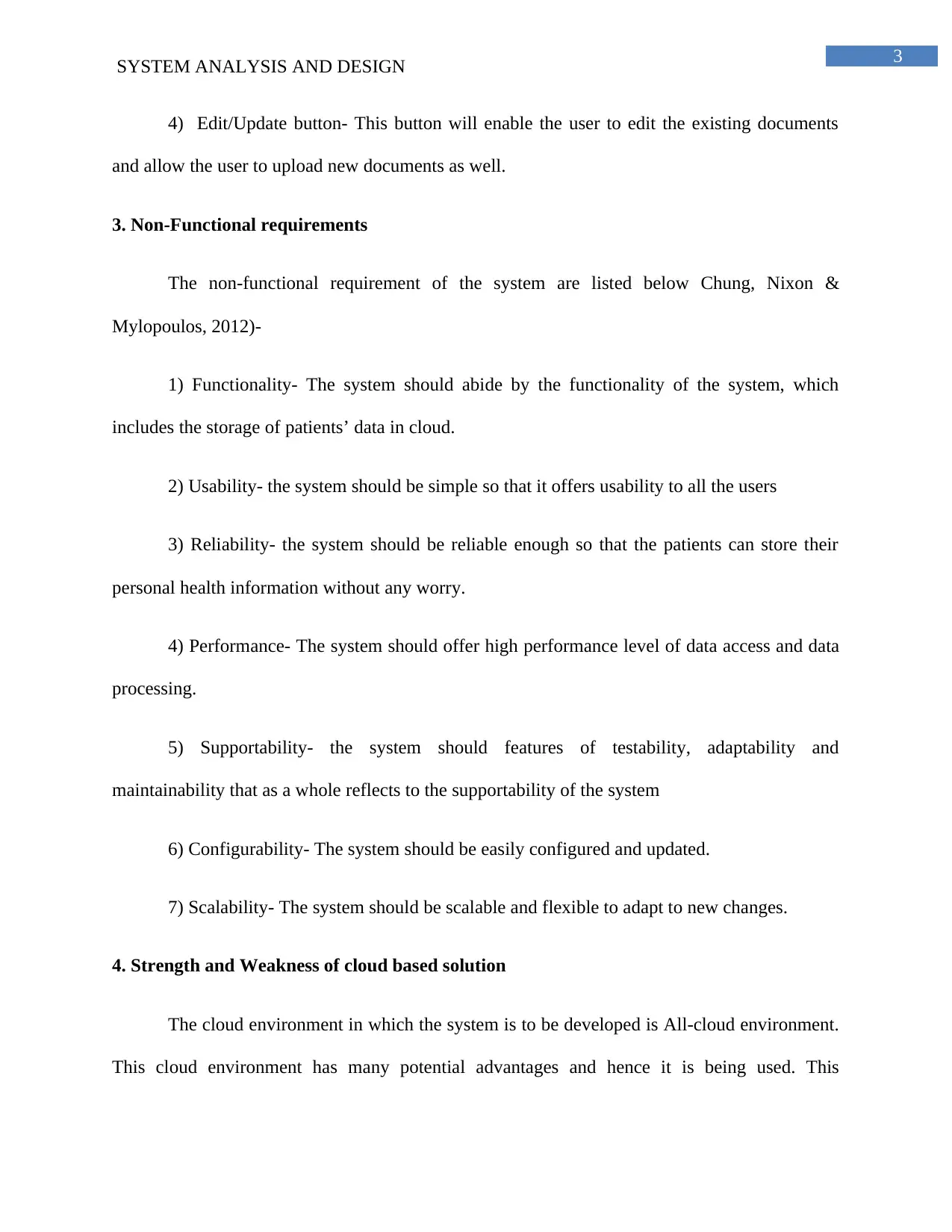
3
SYSTEM ANALYSIS AND DESIGN
4) Edit/Update button- This button will enable the user to edit the existing documents
and allow the user to upload new documents as well.
3. Non-Functional requirements
The non-functional requirement of the system are listed below Chung, Nixon &
Mylopoulos, 2012)-
1) Functionality- The system should abide by the functionality of the system, which
includes the storage of patients’ data in cloud.
2) Usability- the system should be simple so that it offers usability to all the users
3) Reliability- the system should be reliable enough so that the patients can store their
personal health information without any worry.
4) Performance- The system should offer high performance level of data access and data
processing.
5) Supportability- the system should features of testability, adaptability and
maintainability that as a whole reflects to the supportability of the system
6) Configurability- The system should be easily configured and updated.
7) Scalability- The system should be scalable and flexible to adapt to new changes.
4. Strength and Weakness of cloud based solution
The cloud environment in which the system is to be developed is All-cloud environment.
This cloud environment has many potential advantages and hence it is being used. This
SYSTEM ANALYSIS AND DESIGN
4) Edit/Update button- This button will enable the user to edit the existing documents
and allow the user to upload new documents as well.
3. Non-Functional requirements
The non-functional requirement of the system are listed below Chung, Nixon &
Mylopoulos, 2012)-
1) Functionality- The system should abide by the functionality of the system, which
includes the storage of patients’ data in cloud.
2) Usability- the system should be simple so that it offers usability to all the users
3) Reliability- the system should be reliable enough so that the patients can store their
personal health information without any worry.
4) Performance- The system should offer high performance level of data access and data
processing.
5) Supportability- the system should features of testability, adaptability and
maintainability that as a whole reflects to the supportability of the system
6) Configurability- The system should be easily configured and updated.
7) Scalability- The system should be scalable and flexible to adapt to new changes.
4. Strength and Weakness of cloud based solution
The cloud environment in which the system is to be developed is All-cloud environment.
This cloud environment has many potential advantages and hence it is being used. This
Paraphrase This Document
Need a fresh take? Get an instant paraphrase of this document with our AI Paraphraser
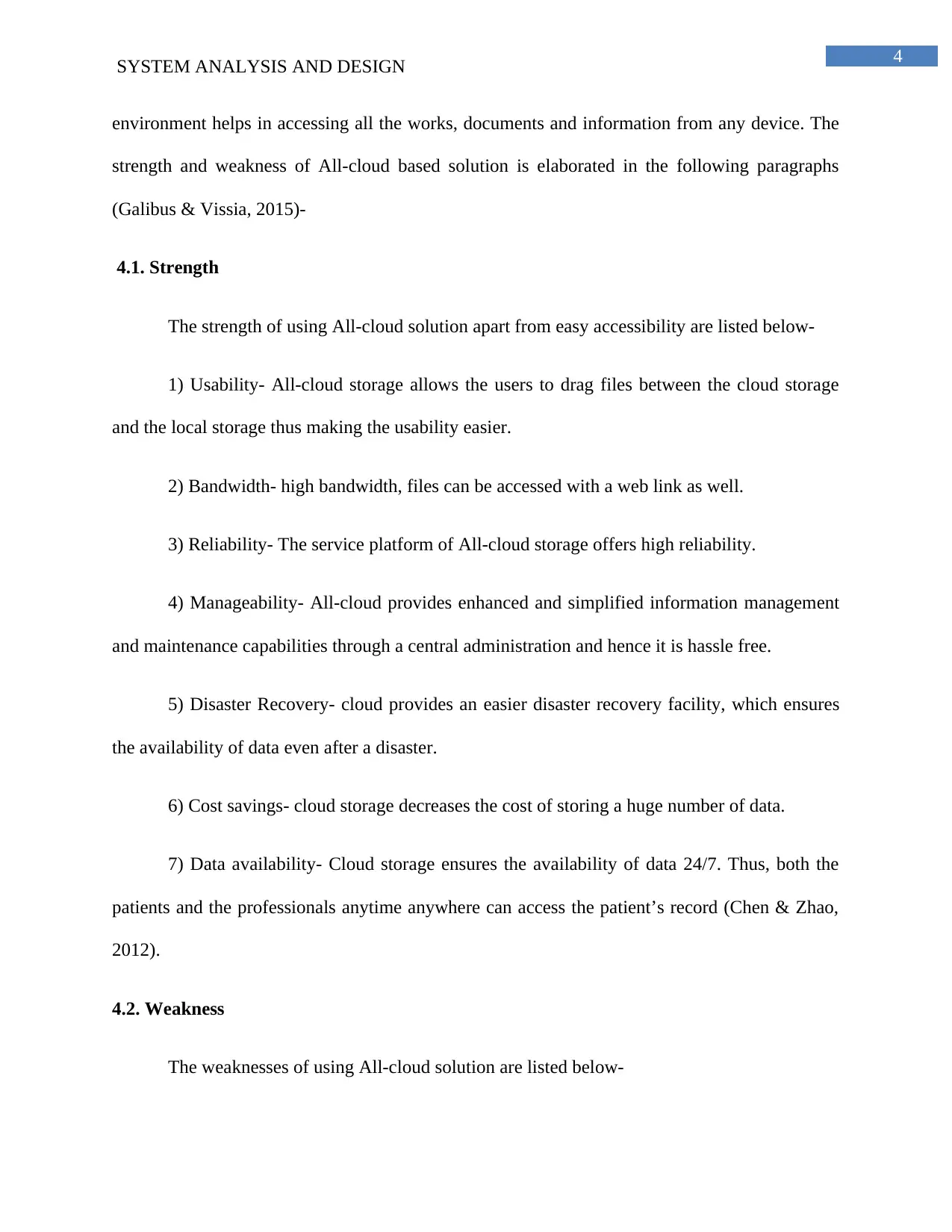
4
SYSTEM ANALYSIS AND DESIGN
environment helps in accessing all the works, documents and information from any device. The
strength and weakness of All-cloud based solution is elaborated in the following paragraphs
(Galibus & Vissia, 2015)-
4.1. Strength
The strength of using All-cloud solution apart from easy accessibility are listed below-
1) Usability- All-cloud storage allows the users to drag files between the cloud storage
and the local storage thus making the usability easier.
2) Bandwidth- high bandwidth, files can be accessed with a web link as well.
3) Reliability- The service platform of All-cloud storage offers high reliability.
4) Manageability- All-cloud provides enhanced and simplified information management
and maintenance capabilities through a central administration and hence it is hassle free.
5) Disaster Recovery- cloud provides an easier disaster recovery facility, which ensures
the availability of data even after a disaster.
6) Cost savings- cloud storage decreases the cost of storing a huge number of data.
7) Data availability- Cloud storage ensures the availability of data 24/7. Thus, both the
patients and the professionals anytime anywhere can access the patient’s record (Chen & Zhao,
2012).
4.2. Weakness
The weaknesses of using All-cloud solution are listed below-
SYSTEM ANALYSIS AND DESIGN
environment helps in accessing all the works, documents and information from any device. The
strength and weakness of All-cloud based solution is elaborated in the following paragraphs
(Galibus & Vissia, 2015)-
4.1. Strength
The strength of using All-cloud solution apart from easy accessibility are listed below-
1) Usability- All-cloud storage allows the users to drag files between the cloud storage
and the local storage thus making the usability easier.
2) Bandwidth- high bandwidth, files can be accessed with a web link as well.
3) Reliability- The service platform of All-cloud storage offers high reliability.
4) Manageability- All-cloud provides enhanced and simplified information management
and maintenance capabilities through a central administration and hence it is hassle free.
5) Disaster Recovery- cloud provides an easier disaster recovery facility, which ensures
the availability of data even after a disaster.
6) Cost savings- cloud storage decreases the cost of storing a huge number of data.
7) Data availability- Cloud storage ensures the availability of data 24/7. Thus, both the
patients and the professionals anytime anywhere can access the patient’s record (Chen & Zhao,
2012).
4.2. Weakness
The weaknesses of using All-cloud solution are listed below-
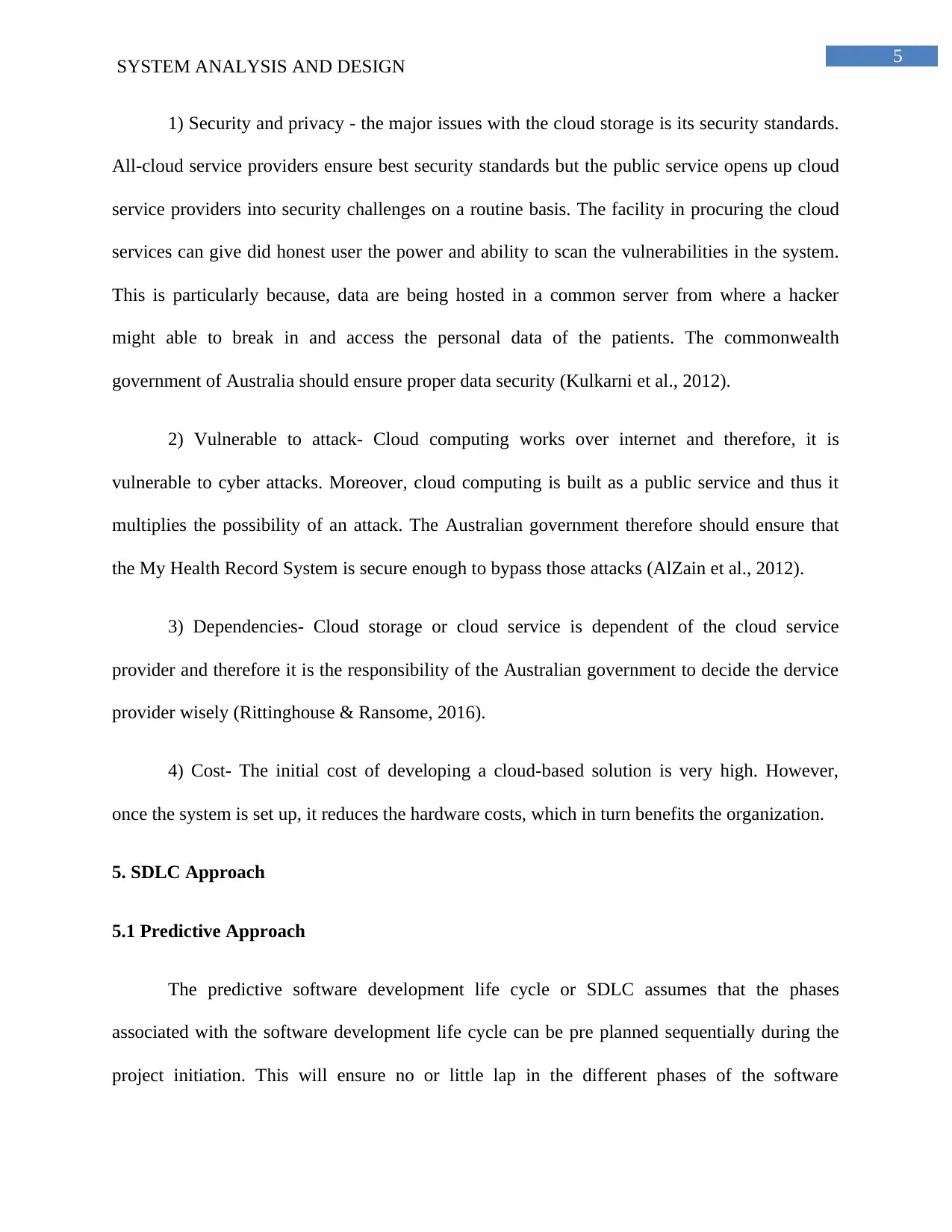
5
SYSTEM ANALYSIS AND DESIGN
1) Security and privacy - the major issues with the cloud storage is its security standards.
All-cloud service providers ensure best security standards but the public service opens up cloud
service providers into security challenges on a routine basis. The facility in procuring the cloud
services can give did honest user the power and ability to scan the vulnerabilities in the system.
This is particularly because, data are being hosted in a common server from where a hacker
might able to break in and access the personal data of the patients. The commonwealth
government of Australia should ensure proper data security (Kulkarni et al., 2012).
2) Vulnerable to attack- Cloud computing works over internet and therefore, it is
vulnerable to cyber attacks. Moreover, cloud computing is built as a public service and thus it
multiplies the possibility of an attack. The Australian government therefore should ensure that
the My Health Record System is secure enough to bypass those attacks (AlZain et al., 2012).
3) Dependencies- Cloud storage or cloud service is dependent of the cloud service
provider and therefore it is the responsibility of the Australian government to decide the dervice
provider wisely (Rittinghouse & Ransome, 2016).
4) Cost- The initial cost of developing a cloud-based solution is very high. However,
once the system is set up, it reduces the hardware costs, which in turn benefits the organization.
5. SDLC Approach
5.1 Predictive Approach
The predictive software development life cycle or SDLC assumes that the phases
associated with the software development life cycle can be pre planned sequentially during the
project initiation. This will ensure no or little lap in the different phases of the software
SYSTEM ANALYSIS AND DESIGN
1) Security and privacy - the major issues with the cloud storage is its security standards.
All-cloud service providers ensure best security standards but the public service opens up cloud
service providers into security challenges on a routine basis. The facility in procuring the cloud
services can give did honest user the power and ability to scan the vulnerabilities in the system.
This is particularly because, data are being hosted in a common server from where a hacker
might able to break in and access the personal data of the patients. The commonwealth
government of Australia should ensure proper data security (Kulkarni et al., 2012).
2) Vulnerable to attack- Cloud computing works over internet and therefore, it is
vulnerable to cyber attacks. Moreover, cloud computing is built as a public service and thus it
multiplies the possibility of an attack. The Australian government therefore should ensure that
the My Health Record System is secure enough to bypass those attacks (AlZain et al., 2012).
3) Dependencies- Cloud storage or cloud service is dependent of the cloud service
provider and therefore it is the responsibility of the Australian government to decide the dervice
provider wisely (Rittinghouse & Ransome, 2016).
4) Cost- The initial cost of developing a cloud-based solution is very high. However,
once the system is set up, it reduces the hardware costs, which in turn benefits the organization.
5. SDLC Approach
5.1 Predictive Approach
The predictive software development life cycle or SDLC assumes that the phases
associated with the software development life cycle can be pre planned sequentially during the
project initiation. This will ensure no or little lap in the different phases of the software
⊘ This is a preview!⊘
Do you want full access?
Subscribe today to unlock all pages.

Trusted by 1+ million students worldwide
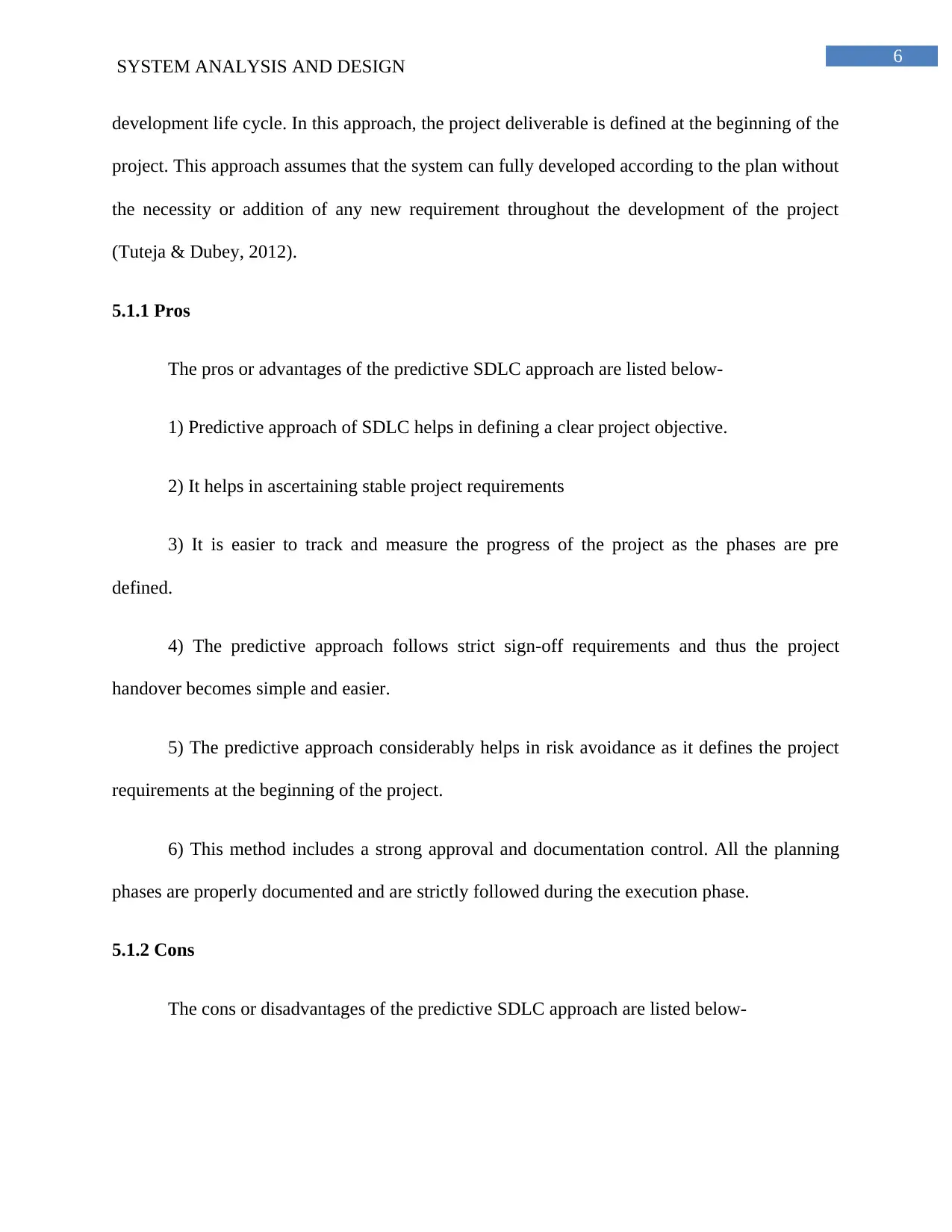
6
SYSTEM ANALYSIS AND DESIGN
development life cycle. In this approach, the project deliverable is defined at the beginning of the
project. This approach assumes that the system can fully developed according to the plan without
the necessity or addition of any new requirement throughout the development of the project
(Tuteja & Dubey, 2012).
5.1.1 Pros
The pros or advantages of the predictive SDLC approach are listed below-
1) Predictive approach of SDLC helps in defining a clear project objective.
2) It helps in ascertaining stable project requirements
3) It is easier to track and measure the progress of the project as the phases are pre
defined.
4) The predictive approach follows strict sign-off requirements and thus the project
handover becomes simple and easier.
5) The predictive approach considerably helps in risk avoidance as it defines the project
requirements at the beginning of the project.
6) This method includes a strong approval and documentation control. All the planning
phases are properly documented and are strictly followed during the execution phase.
5.1.2 Cons
The cons or disadvantages of the predictive SDLC approach are listed below-
SYSTEM ANALYSIS AND DESIGN
development life cycle. In this approach, the project deliverable is defined at the beginning of the
project. This approach assumes that the system can fully developed according to the plan without
the necessity or addition of any new requirement throughout the development of the project
(Tuteja & Dubey, 2012).
5.1.1 Pros
The pros or advantages of the predictive SDLC approach are listed below-
1) Predictive approach of SDLC helps in defining a clear project objective.
2) It helps in ascertaining stable project requirements
3) It is easier to track and measure the progress of the project as the phases are pre
defined.
4) The predictive approach follows strict sign-off requirements and thus the project
handover becomes simple and easier.
5) The predictive approach considerably helps in risk avoidance as it defines the project
requirements at the beginning of the project.
6) This method includes a strong approval and documentation control. All the planning
phases are properly documented and are strictly followed during the execution phase.
5.1.2 Cons
The cons or disadvantages of the predictive SDLC approach are listed below-
Paraphrase This Document
Need a fresh take? Get an instant paraphrase of this document with our AI Paraphraser
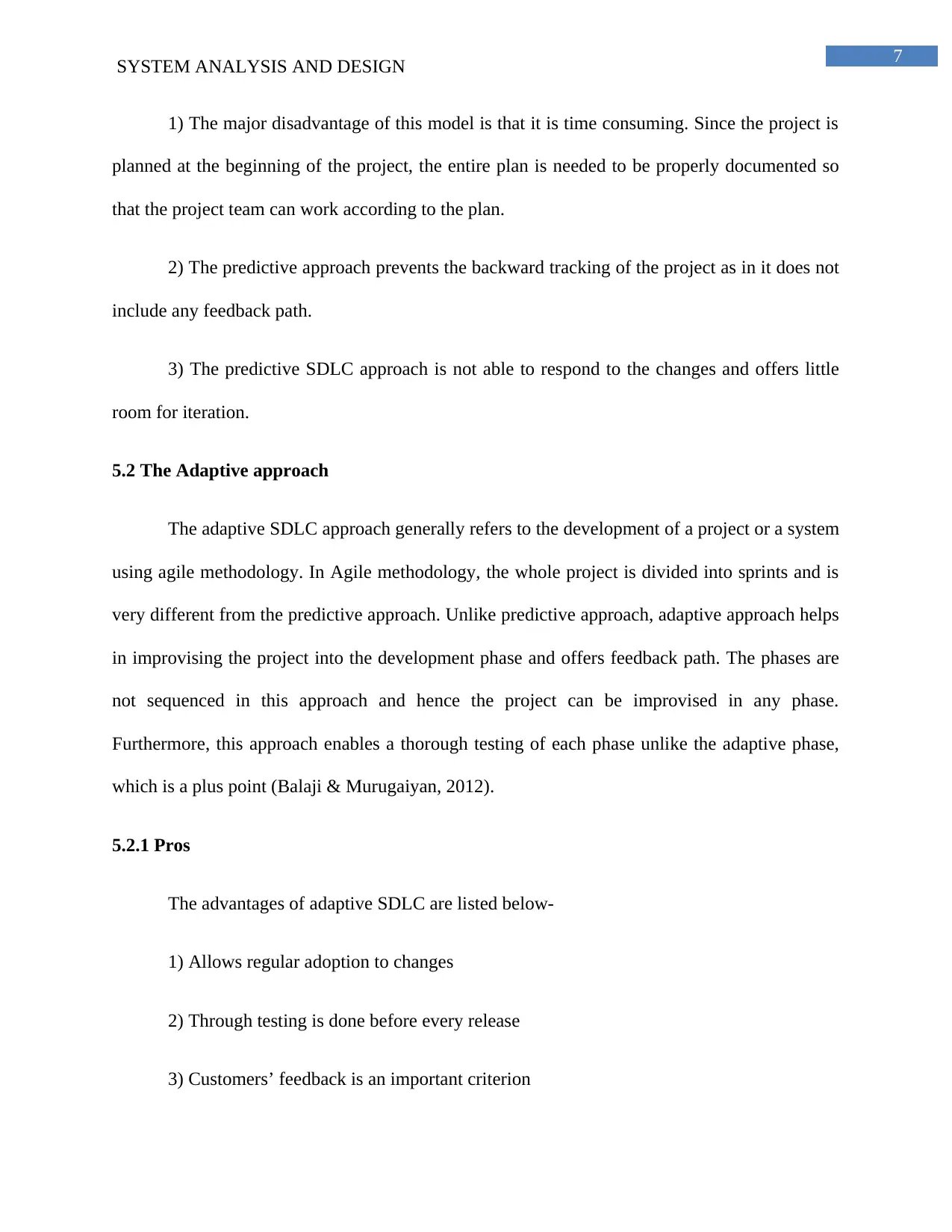
7
SYSTEM ANALYSIS AND DESIGN
1) The major disadvantage of this model is that it is time consuming. Since the project is
planned at the beginning of the project, the entire plan is needed to be properly documented so
that the project team can work according to the plan.
2) The predictive approach prevents the backward tracking of the project as in it does not
include any feedback path.
3) The predictive SDLC approach is not able to respond to the changes and offers little
room for iteration.
5.2 The Adaptive approach
The adaptive SDLC approach generally refers to the development of a project or a system
using agile methodology. In Agile methodology, the whole project is divided into sprints and is
very different from the predictive approach. Unlike predictive approach, adaptive approach helps
in improvising the project into the development phase and offers feedback path. The phases are
not sequenced in this approach and hence the project can be improvised in any phase.
Furthermore, this approach enables a thorough testing of each phase unlike the adaptive phase,
which is a plus point (Balaji & Murugaiyan, 2012).
5.2.1 Pros
The advantages of adaptive SDLC are listed below-
1) Allows regular adoption to changes
2) Through testing is done before every release
3) Customers’ feedback is an important criterion
SYSTEM ANALYSIS AND DESIGN
1) The major disadvantage of this model is that it is time consuming. Since the project is
planned at the beginning of the project, the entire plan is needed to be properly documented so
that the project team can work according to the plan.
2) The predictive approach prevents the backward tracking of the project as in it does not
include any feedback path.
3) The predictive SDLC approach is not able to respond to the changes and offers little
room for iteration.
5.2 The Adaptive approach
The adaptive SDLC approach generally refers to the development of a project or a system
using agile methodology. In Agile methodology, the whole project is divided into sprints and is
very different from the predictive approach. Unlike predictive approach, adaptive approach helps
in improvising the project into the development phase and offers feedback path. The phases are
not sequenced in this approach and hence the project can be improvised in any phase.
Furthermore, this approach enables a thorough testing of each phase unlike the adaptive phase,
which is a plus point (Balaji & Murugaiyan, 2012).
5.2.1 Pros
The advantages of adaptive SDLC are listed below-
1) Allows regular adoption to changes
2) Through testing is done before every release
3) Customers’ feedback is an important criterion
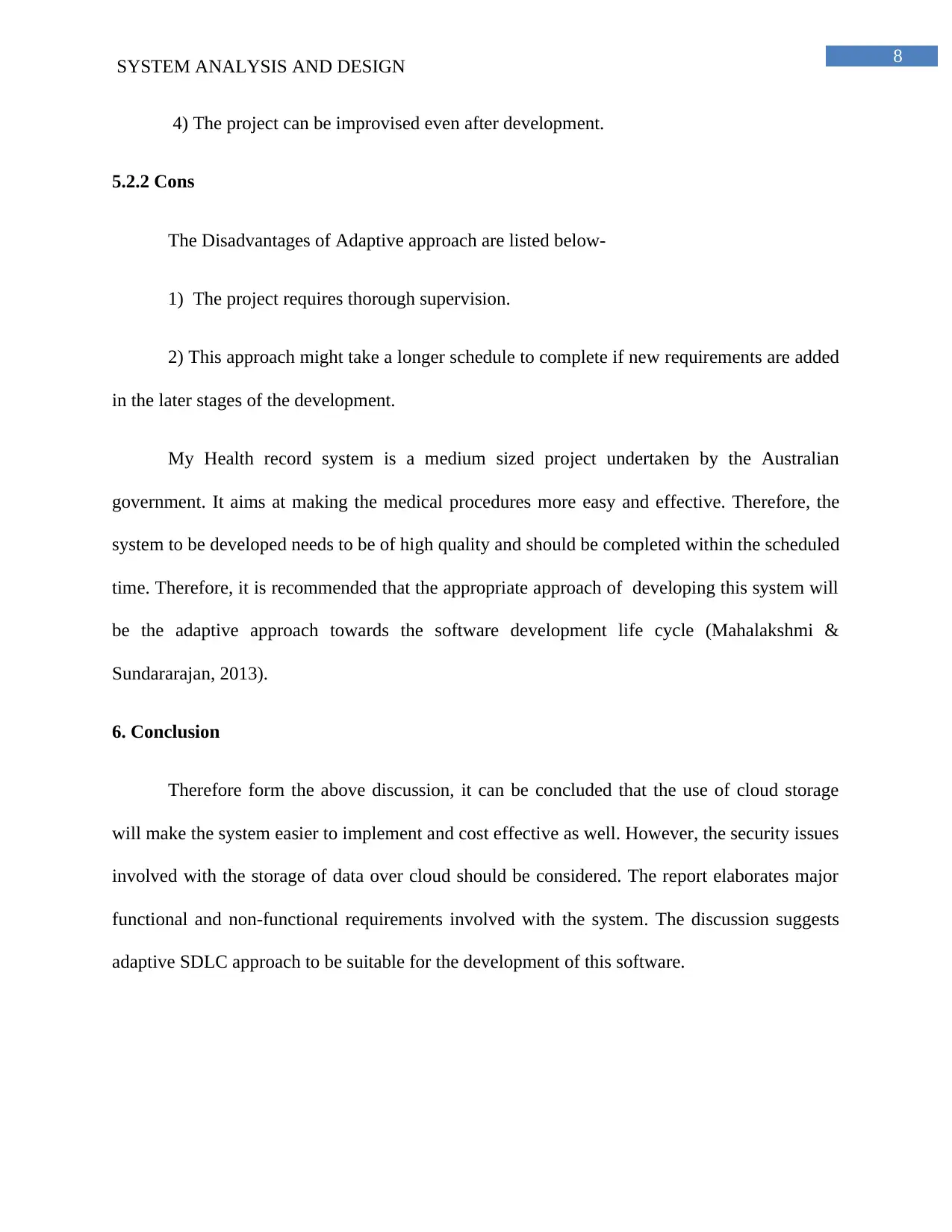
8
SYSTEM ANALYSIS AND DESIGN
4) The project can be improvised even after development.
5.2.2 Cons
The Disadvantages of Adaptive approach are listed below-
1) The project requires thorough supervision.
2) This approach might take a longer schedule to complete if new requirements are added
in the later stages of the development.
My Health record system is a medium sized project undertaken by the Australian
government. It aims at making the medical procedures more easy and effective. Therefore, the
system to be developed needs to be of high quality and should be completed within the scheduled
time. Therefore, it is recommended that the appropriate approach of developing this system will
be the adaptive approach towards the software development life cycle (Mahalakshmi &
Sundararajan, 2013).
6. Conclusion
Therefore form the above discussion, it can be concluded that the use of cloud storage
will make the system easier to implement and cost effective as well. However, the security issues
involved with the storage of data over cloud should be considered. The report elaborates major
functional and non-functional requirements involved with the system. The discussion suggests
adaptive SDLC approach to be suitable for the development of this software.
SYSTEM ANALYSIS AND DESIGN
4) The project can be improvised even after development.
5.2.2 Cons
The Disadvantages of Adaptive approach are listed below-
1) The project requires thorough supervision.
2) This approach might take a longer schedule to complete if new requirements are added
in the later stages of the development.
My Health record system is a medium sized project undertaken by the Australian
government. It aims at making the medical procedures more easy and effective. Therefore, the
system to be developed needs to be of high quality and should be completed within the scheduled
time. Therefore, it is recommended that the appropriate approach of developing this system will
be the adaptive approach towards the software development life cycle (Mahalakshmi &
Sundararajan, 2013).
6. Conclusion
Therefore form the above discussion, it can be concluded that the use of cloud storage
will make the system easier to implement and cost effective as well. However, the security issues
involved with the storage of data over cloud should be considered. The report elaborates major
functional and non-functional requirements involved with the system. The discussion suggests
adaptive SDLC approach to be suitable for the development of this software.
⊘ This is a preview!⊘
Do you want full access?
Subscribe today to unlock all pages.

Trusted by 1+ million students worldwide
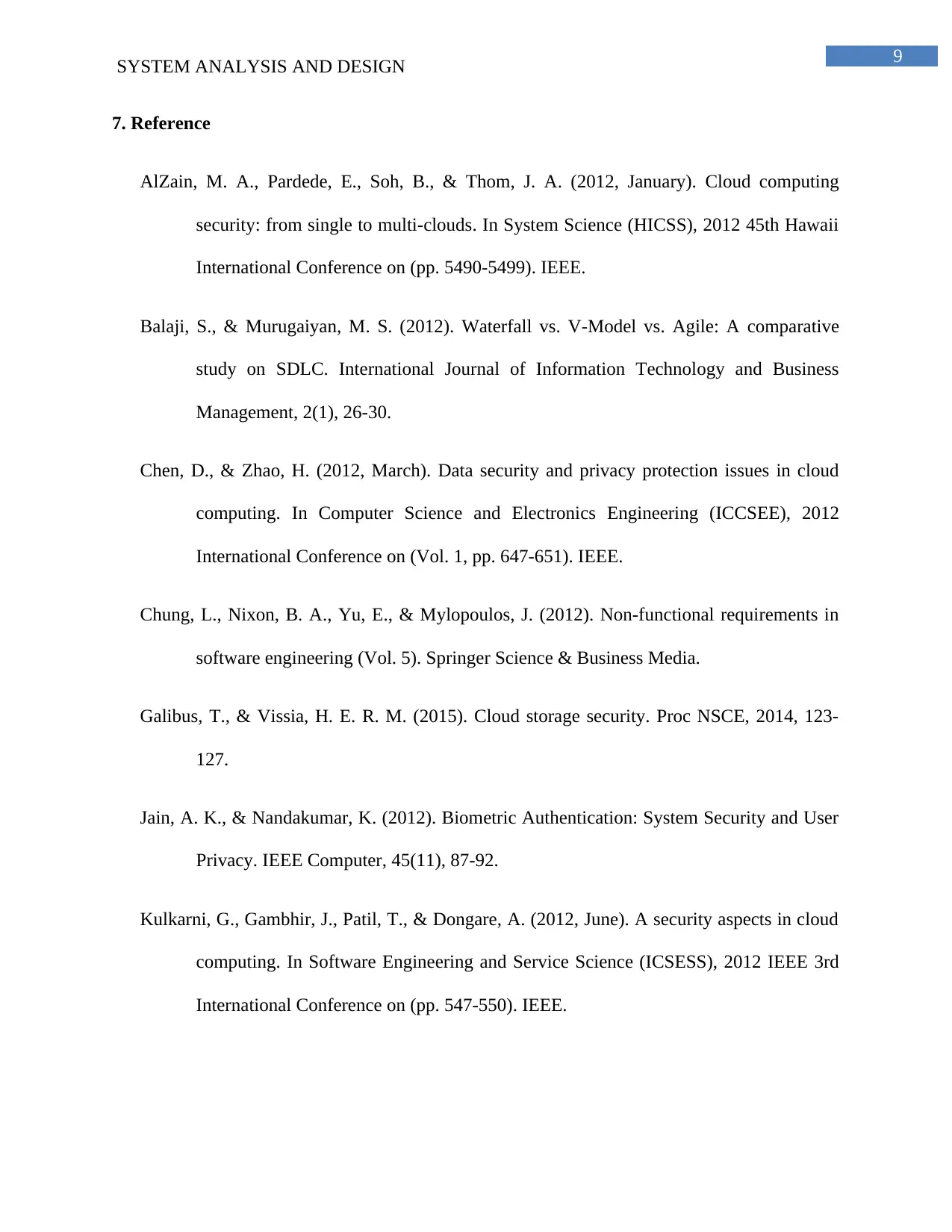
9
SYSTEM ANALYSIS AND DESIGN
7. Reference
AlZain, M. A., Pardede, E., Soh, B., & Thom, J. A. (2012, January). Cloud computing
security: from single to multi-clouds. In System Science (HICSS), 2012 45th Hawaii
International Conference on (pp. 5490-5499). IEEE.
Balaji, S., & Murugaiyan, M. S. (2012). Waterfall vs. V-Model vs. Agile: A comparative
study on SDLC. International Journal of Information Technology and Business
Management, 2(1), 26-30.
Chen, D., & Zhao, H. (2012, March). Data security and privacy protection issues in cloud
computing. In Computer Science and Electronics Engineering (ICCSEE), 2012
International Conference on (Vol. 1, pp. 647-651). IEEE.
Chung, L., Nixon, B. A., Yu, E., & Mylopoulos, J. (2012). Non-functional requirements in
software engineering (Vol. 5). Springer Science & Business Media.
Galibus, T., & Vissia, H. E. R. M. (2015). Cloud storage security. Proc NSCE, 2014, 123-
127.
Jain, A. K., & Nandakumar, K. (2012). Biometric Authentication: System Security and User
Privacy. IEEE Computer, 45(11), 87-92.
Kulkarni, G., Gambhir, J., Patil, T., & Dongare, A. (2012, June). A security aspects in cloud
computing. In Software Engineering and Service Science (ICSESS), 2012 IEEE 3rd
International Conference on (pp. 547-550). IEEE.
SYSTEM ANALYSIS AND DESIGN
7. Reference
AlZain, M. A., Pardede, E., Soh, B., & Thom, J. A. (2012, January). Cloud computing
security: from single to multi-clouds. In System Science (HICSS), 2012 45th Hawaii
International Conference on (pp. 5490-5499). IEEE.
Balaji, S., & Murugaiyan, M. S. (2012). Waterfall vs. V-Model vs. Agile: A comparative
study on SDLC. International Journal of Information Technology and Business
Management, 2(1), 26-30.
Chen, D., & Zhao, H. (2012, March). Data security and privacy protection issues in cloud
computing. In Computer Science and Electronics Engineering (ICCSEE), 2012
International Conference on (Vol. 1, pp. 647-651). IEEE.
Chung, L., Nixon, B. A., Yu, E., & Mylopoulos, J. (2012). Non-functional requirements in
software engineering (Vol. 5). Springer Science & Business Media.
Galibus, T., & Vissia, H. E. R. M. (2015). Cloud storage security. Proc NSCE, 2014, 123-
127.
Jain, A. K., & Nandakumar, K. (2012). Biometric Authentication: System Security and User
Privacy. IEEE Computer, 45(11), 87-92.
Kulkarni, G., Gambhir, J., Patil, T., & Dongare, A. (2012, June). A security aspects in cloud
computing. In Software Engineering and Service Science (ICSESS), 2012 IEEE 3rd
International Conference on (pp. 547-550). IEEE.
Paraphrase This Document
Need a fresh take? Get an instant paraphrase of this document with our AI Paraphraser
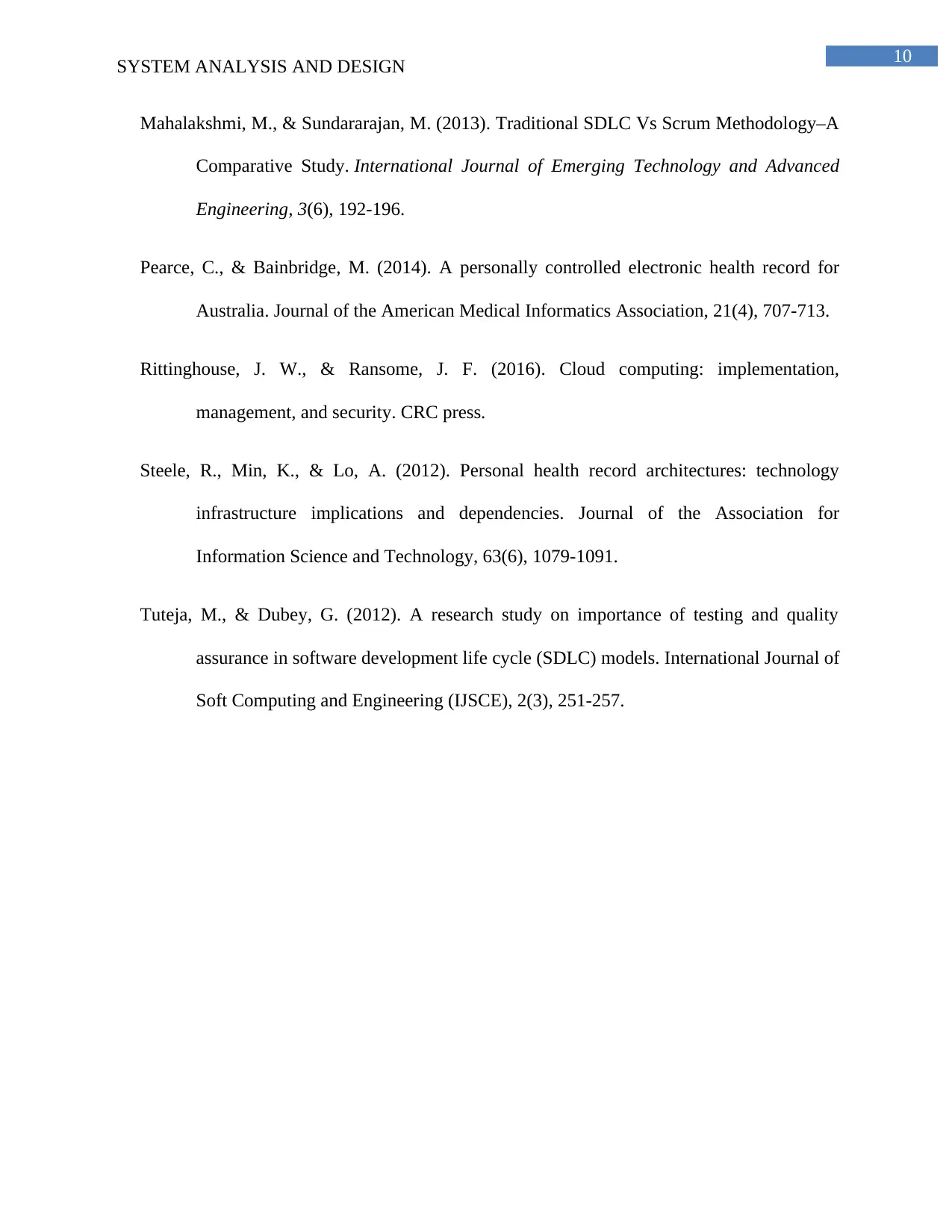
10
SYSTEM ANALYSIS AND DESIGN
Mahalakshmi, M., & Sundararajan, M. (2013). Traditional SDLC Vs Scrum Methodology–A
Comparative Study. International Journal of Emerging Technology and Advanced
Engineering, 3(6), 192-196.
Pearce, C., & Bainbridge, M. (2014). A personally controlled electronic health record for
Australia. Journal of the American Medical Informatics Association, 21(4), 707-713.
Rittinghouse, J. W., & Ransome, J. F. (2016). Cloud computing: implementation,
management, and security. CRC press.
Steele, R., Min, K., & Lo, A. (2012). Personal health record architectures: technology
infrastructure implications and dependencies. Journal of the Association for
Information Science and Technology, 63(6), 1079-1091.
Tuteja, M., & Dubey, G. (2012). A research study on importance of testing and quality
assurance in software development life cycle (SDLC) models. International Journal of
Soft Computing and Engineering (IJSCE), 2(3), 251-257.
SYSTEM ANALYSIS AND DESIGN
Mahalakshmi, M., & Sundararajan, M. (2013). Traditional SDLC Vs Scrum Methodology–A
Comparative Study. International Journal of Emerging Technology and Advanced
Engineering, 3(6), 192-196.
Pearce, C., & Bainbridge, M. (2014). A personally controlled electronic health record for
Australia. Journal of the American Medical Informatics Association, 21(4), 707-713.
Rittinghouse, J. W., & Ransome, J. F. (2016). Cloud computing: implementation,
management, and security. CRC press.
Steele, R., Min, K., & Lo, A. (2012). Personal health record architectures: technology
infrastructure implications and dependencies. Journal of the Association for
Information Science and Technology, 63(6), 1079-1091.
Tuteja, M., & Dubey, G. (2012). A research study on importance of testing and quality
assurance in software development life cycle (SDLC) models. International Journal of
Soft Computing and Engineering (IJSCE), 2(3), 251-257.
1 out of 11
Related Documents
Your All-in-One AI-Powered Toolkit for Academic Success.
+13062052269
info@desklib.com
Available 24*7 on WhatsApp / Email
![[object Object]](/_next/static/media/star-bottom.7253800d.svg)
Unlock your academic potential
Copyright © 2020–2025 A2Z Services. All Rights Reserved. Developed and managed by ZUCOL.





